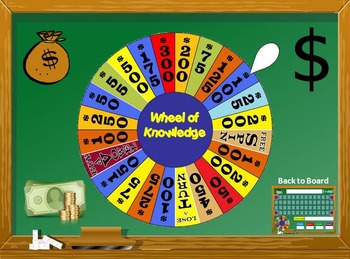Money Wheel
The Wheel Strategy is a systematic and very powerful way to sell covered calls as part of a long-term trading strategy.
- To make the wheel, gather your plate, sharpie, hot glue gun, nails, and ruler. To make the 'slot', first draw a line, and the next line should be 2.5 inches from the first line. After you are done, take a small circle item, and trace in the middle of the plate where all the lines intersect. You may color the inner circle if you choose.
- T-SIGN 12 Inch Heavy Duty Spinning Prize Wheel, 10 Slots Color Tabletop Prize Wheel Spinner with Dry Erase Markers and Eraser for Carnival and Trade Show, Win The Fortune Spin Game 4.3 out of 5 stars 1,004.
- MONEY WHEEL Fun, exciting, and easy to play, the Money Wheel is a great game for first time casino players and remains a thrilling experience for experienced gamers. The Money Wheel is played with a wheel, whose rim is divided, by means of pegs, into 52 equally spaced sections.
The process starts with a selling a cash secured put. The investor also needs to be willing, and have the funds available to purchase 200 shares.
After selling the initial put, the put either expires or is assigned. If it expires, they keep the premium and start again if they are still bullish on the stock, or they move on to another stock. If they are assigned, they take ownership of 100 shares.
At this point they sell a call to turn it into a covered call and they also sell a new put.
From here, if the stock goes up through your call, you are assigned and the stock is called away leaving you flat. As the stock went up, your sold put expires worthless.
If the stock goes down, you are assigned on the second put, and you now have your full allocation of 200 shares. As the stock went down, the call expires worthless.
Now that you own 200 shares, you sell two calls.

1-16 of over 70,000 results for 'Money Wheels' Price and other details may vary based on size and color. Making Money with Mobile Homes. Book 2 of 1: Making Money with Mobile Homes. You could win Big Money and fantastic prizes from Wheel of Fortune!
If the stock goes up through the calls, the stock is called away and your position is flat again.
Through the process you have collected 5 option premiums, plus any dividends while holding the shares, plus potentially some capital gains, depending at which strikes you sold the calls and puts.
If the stock continues down, you can continue to sell 2 covered calls each month.
This process is best explained in the following diagram:
This is just the theory of course, and in practice, things don’t always work out so smoothly.
One trap investors can fall in to is continuing to hold on to shares as the stock falls due to the attraction of generating option premium.
Stop losses are important. Have a think how this strategy would have performed on a stock like Lehman Brothers during the Financial Crisis.
If a stock has dropped 10%, it might be time to cut and run. You don’t want to keep adding to a losing position by buying more shares. In this case what can happen is that you end up selling calls for less than your cost basis, meaning that even if your stock goes up through your calls, you are still left with a loss.
Here are some things you might want to consider when looking at this strategy:
- Sell the first put when implied volatility is in the higher end of the 6-month range
- Wait for a 5% pullback before selling the first put
- Place a stop loss 10-15% below where the stock was trading when the put was first sold
- Adjust your stop loss lower when multiple puts have expired worthless
- Will you sell the first put slightly out-of-the-money or at-the-money?
- Will you sell the calls slightly out-of-the-money or at-the-money?
- Sell the first put when RSI is below 30
- Stick to low beta, high dividend stocks. Think of stocks you would be happy to own in your retirement account
- You can also use this strategy on ETF’s to reduce the bankruptcy risk
- If the stock continues to fall, it’s ok to sell a call below cost only if you have received enough put premiums to offset the cost basis
- If you have sold numerous puts, your actual cost basis can be very low
THEORETICAL EXAMPLE
Let’s look at a theoretical example to see exactly how the strategy works and then I’ll share some trades from my own account.
In April, 2014 JNJ was trading at $98.
We start by selling a June $95 put for $1.50.
Money Wheel Images
JNJ then falls below $95; we are assigned on the put and take ownership of 100 shares with a cost basis of $93.50 (95 less the 1.50 option premium).
Now we sell an October $97.50 Call for $1.50 and an October $90 Put for $1.50.
So far we have received a total of $450 in option premium (3 x $150) and we have paid $9,500 for the 100 shares. The cost basis is $9,050 or $90.50 per share.
As October expiry, JNJ falls below $90. We are assigned on another 100 shares at $90.
We now sell two January $95 calls for $1.50.
We have been assigned on the shares at $95 and $90 totaling $18,500.
We’ve received 5 x $150 in premium from call and put sales.
Our net cost basis is $17,750 or $88.75 per share.
If JNJ is below $95 at January expiry, we sell two more calls and continue to collect the dividends.
If JNJ is above $95, our 200 shares are called away leaving our position flat. The total profit is $95 – $88.75 x 200 = $1,250.
Not bad for a stock that has fallen from $98 to $95 over the course of the trade.

TWO REAL TRADE EXAMPLES
The following is an example that I like to share with coaching clients. It’s a good example because it occurred during the 2008-2009 financial crisis. On a stock that dropped 42%, I made a profit of $1,440.
However, I was lucky, and at one point I was in a pretty big hole. Realistically I should have been stopped out of the trade in mid to late 2008 but I stuck with it and rode it out. If someone tried this on Bear Sterns, Lehman Brothers or AIG, they wouldn’t have been so lucky.
Here is the trade history. You can see that I started the trade via a covered call on GE when it was trading at $31.98.
Over the course of the trade I bought stock as follows:
Money Wheel online, free
100 shares at $31.78 in April 2008
100 shares at $26.57 in July 2008 average cost now $29.18
200 shares at $8.95 in February 2009 average cost now $19.06
200 share at $16.00 in December 2009 average cost now $18.04
In total I generated $981.28 in option premiums after commissions and received $342.30 in dividends after tax.
To close the trade, I ended up buying back the $18 calls in December 2010 and selling the shares for $18.32.
Money Wheel Slot Machine
All up the trade made a profit of $1,440 while the stock declined by 42% over the course of the trade.
Even though I’ll freely admit the trade wasn’t managed very well, you can see how powerful this strategy can be.
Here is another trade example that worked out a little more smoothly than the GE trade.
You can see that in this case, EWZ rose by 6.03% over the course of the trade.

The profit on the wheel trade was $438 on capital at risk of $6,200 which equates to a 7.08% return.
The wheel strategy is a really powerful income strategy that can enhance your long-term returns. There are risks and it’s important that investors are careful not to get sucked in to averaging down on losers.
Wheel trades can be very straight forward as we saw in the EWZ example, or they can be very painful and tie up capital for a long time as we saw in the GE trade.
What do you think about this strategy? Let me know in the comments below.
Introduction: DIY Money Wheel
Take the wheel for a spin and win some Cash... ranging from $.25 to $10!
Step 1: Materials

You will need:
banana stand
Screwdriver
Nails
Paper Plate
Sharpie
Duct tape
Clamp
Binder Clip
Hot Glue Gun
Money Wheel Game
Step 2: Making the Wheel
To make the wheel, gather your plate, sharpie, hot glue gun, nails, and ruler.
To make the 'slot', first draw a line, and the next line should be 2.5 inches from the first line.
After you are done, take a small circle item, and trace in the middle of the plate where all the lines intersect.
You may color the inner circle if you choose.
Trace the outer lines with a sharpie.
Add the nails to each of the lines, and one in the middle
Write in correct money values.
Step 3: The Stand
To make the stand, gather the banana stand, duct tape, eraser, screwdriver, clamp, and binder clip.
Duct tape the screw driver to the top of the stand, so the driver part sticks out (this will be used to spin the wheel.)
Insert the plate onto the screwdriver, and then the eraser goes into the screwdriver over the plate (so the wheel does not go all wiggly)
Cut out a triangle shape out of duct tape, and attach to binder clip.
attach the binder clip to the clamp, and bend so the arrow is pointing down.
Find where the point is that the duct tape arrow will spin at, and duct tape the clamp to the stand.
Step 4: TAKE a SPIN
So here's how it works...
It's a gambling game...
Have someone pay you five dollars to play, give them one spin, and what they land on they can keep.
Participated in the
ShopBot Challenge
Be the First to Share
Recommendations
Self-Care Challenge
Make it Glow Contest
First Time Author Contest